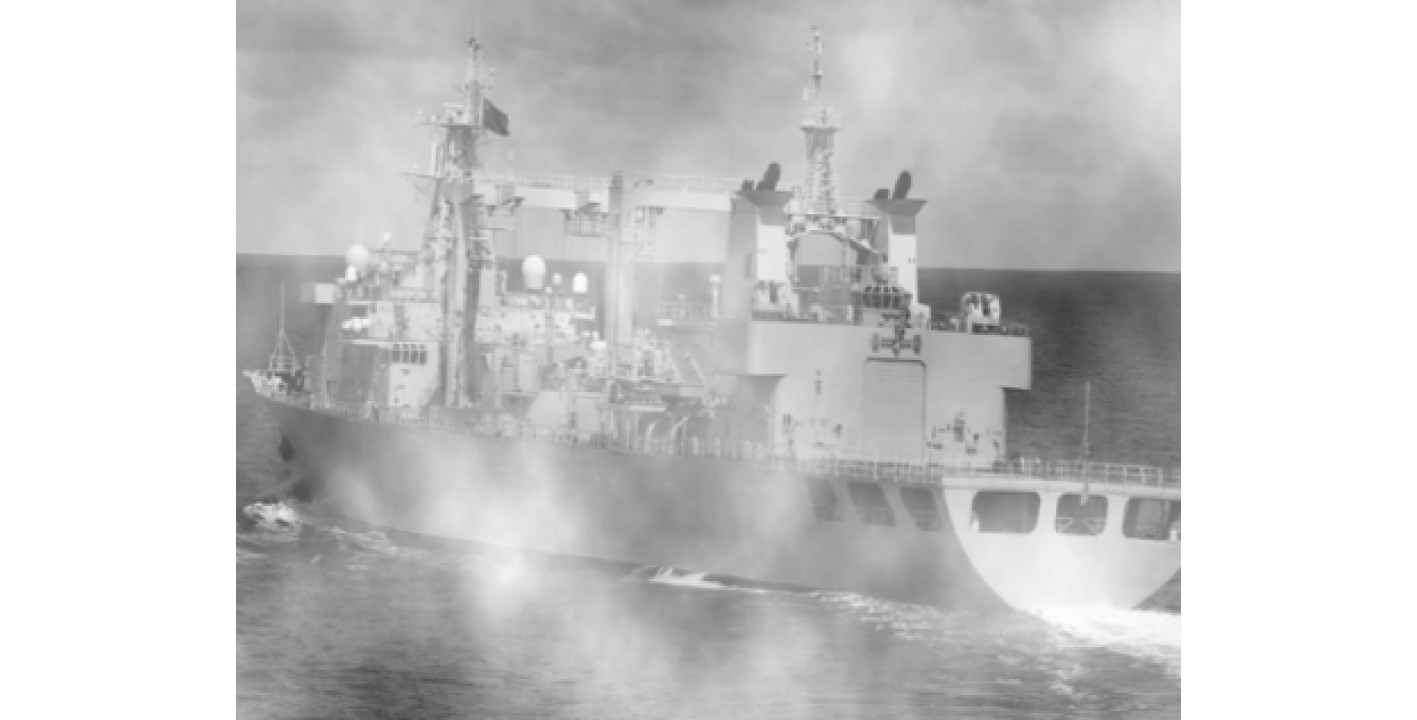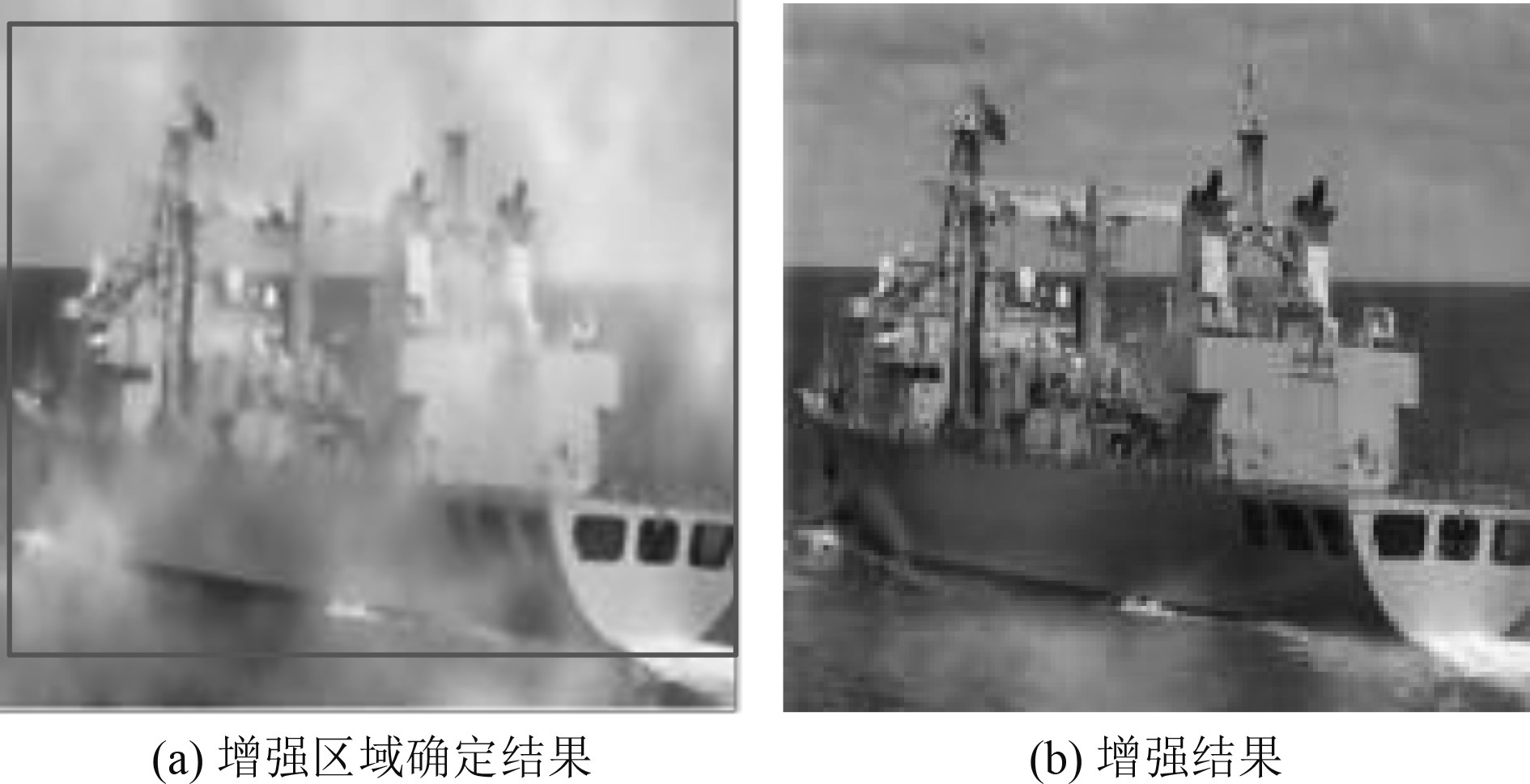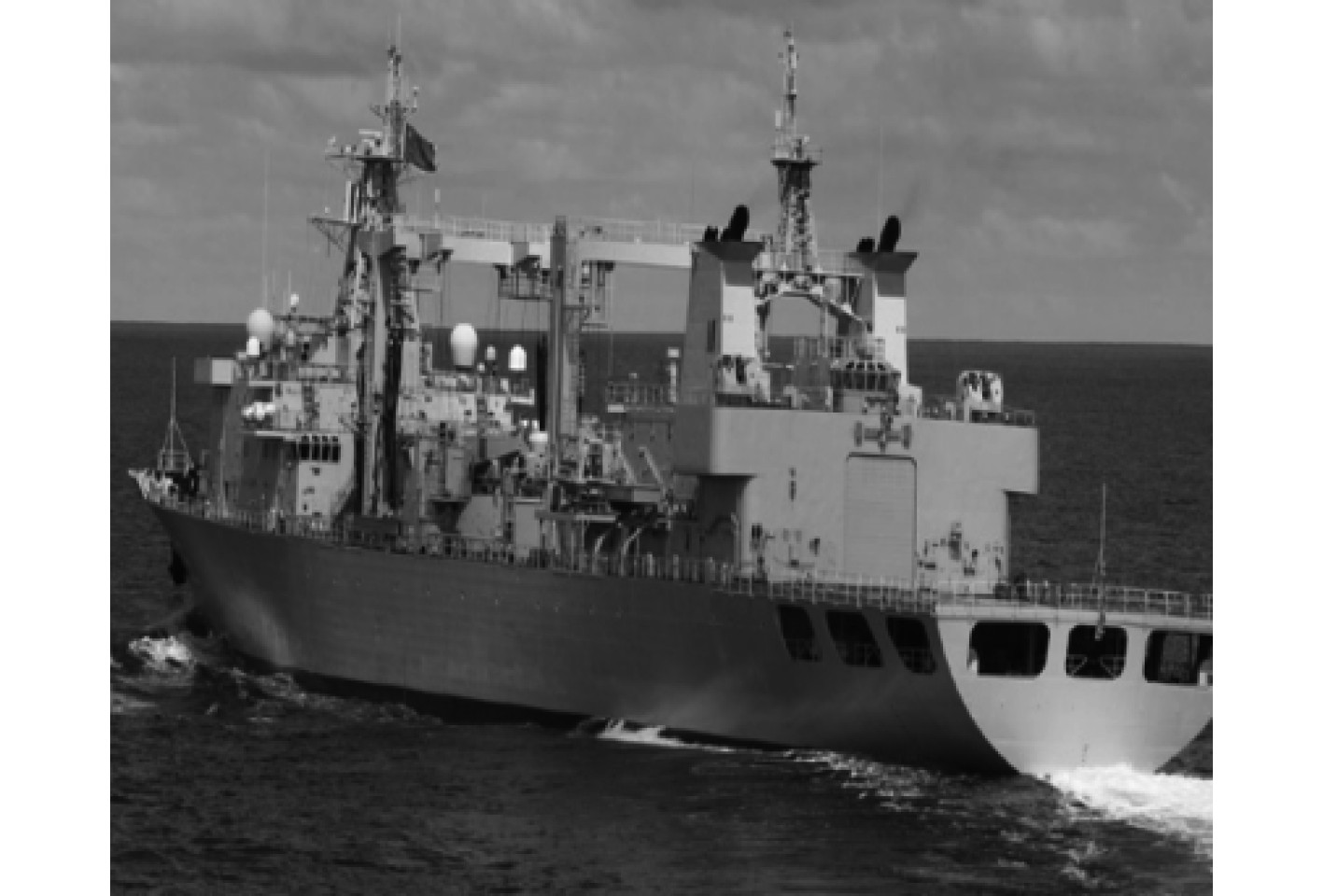受雾天影响,采集的舰船图像不够清晰,舰船图像质量较差[1-2],导致其不具备较好的使用价值,视觉传达效果较差,无法为舰船图像应用提供有价值的信息[3]。为此,需要研究视觉传达方法,提升图像的使用价值。林伟等[4]利用小波分解去除图像噪声,通过改进粒子群算法,增强视觉传达图像对比度,完成图像视觉传达。该方法具备较优的视觉传达效果。但仅适合正常图像的视觉传达,在图像清晰度较差情况下,无法确保图像的真实性,提升图像边缘清晰度,影响视觉传达效果。时空域滤波可较好地增强图像细节信息,在保留原始图像真实性的同时,还能够提升图像边缘清晰度。为此,提出基于时空域滤波的雾天舰船图像视觉传达方法,提升舰船图像清晰度。
1 雾天舰船图像视觉传达方法 1.1 雾天舰船图像分解依据雾天舰船图像m(x,y)的退化原理,构造舰船图像雾气退化模型m(x,y),令空气散射系数为β,m(x,y)的公式如下:
| $ \begin{gathered} m\left( {x,y} \right) = b\left( {x,y} \right) \cdot \exp \left[ { - \beta \cdot d\left( x \right)} \right] + \\ A - A \cdot \exp \left[ { - \beta \cdot d\left( x \right)} \right] + n\left( {x,y} \right)。\\ \end{gathered} $ | (1) |
其中:
| $ b\left( {x,y} \right) = {b_1}\left( {x,y} \right) + {b_2}\left( {x,y} \right),$ | (2) |
依据式(2)变更式(1)得:
| $ \begin{gathered} m\left( {x,y} \right) = {b_1}\left( {x,y} \right) \cdot \exp \left[ { - \beta \cdot d\left( x \right)} \right] + A - \\ A \cdot \exp \left[ { - \beta \cdot d\left( x \right)} \right] + {b_2}\left( {x,y} \right) \cdot \exp \left[ { - \beta \cdot d\left( x \right)} \right] + n\left( {x,y} \right),\\ \end{gathered} $ | (3) |
按照中值滤波算法,结合式(3)分解雾天舰船图像,公式如下:
| $ \begin{gathered} m\left( {x,y} \right) = {b_1}\left( {x,y} \right) \cdot \exp \left[ { - \beta \cdot d\left( x \right)} \right] + A - A \cdot \exp \left[ { - \beta \cdot d\left( x \right)} \right] + \\ {b_2}\left( {x,y} \right) \cdot \exp \left[ { - \beta \cdot d\left( x \right)} \right] + n\left( {x,y} \right) 。\\ \end{gathered} $ | (4) |
其中:
利用时空域滤波先对分解后的基础层、细节层雾天舰船图像,分别进行需增强区域划分,再对划分后的区域进行雾天舰船图像增强。以基础层雾天舰船图像m1(x,y)增强为例。在m1(x,y)内随机选择两点
| $ \left\{ \begin{gathered} \sin sk = \frac{{{z_1} - {z_2}}}{{z_1^2 - z_2^2 + h_1^2 - h_2^2}} ,\\ \sin ks = \frac{{{z_2} - {z_1}}}{{z_1^2 - z_2^2 + h_1^2 - h_2^2}} ,\\ \cos sk = \frac{{{h_1} - {h_2}}}{{z_1^2 - z_2^2 + h_1^2 - h_2^2}} ,\\ \cos ks = \frac{{{h_2} - {h_1}}}{{z_1^2 - z_2^2 + h_2^2 - h_1^2}}。\\ \end{gathered} \right. $ | (5) |
其中:
通过强化
| $ \left\{ \begin{gathered} r = \gamma \times {r_0} + \sin sk ,\\ r = \gamma \times {r_0} + \sin ks,\\ r = \gamma \times {r_0} + \cos sk,\\ r = \gamma \times {r_0} + \cos ks。\\ \end{gathered} \right. $ | (6) |
其中:
依据
| $ \rho \left( q \right) = \frac{{{u^{ - \frac{{{q^2}}}{{2{\delta ^2}}}}}}}{{\sqrt {2\text{π} {\delta ^2}} }},$ | (7) |
其中,
根据
| $ \eta = \int_{ - \infty }^\infty {\rho \left( q \right){u^{jq}}{\rm{d}}q},$ | (8) |
其中,
以积分公式求解式(8),公式如下:
| $ \eta = \sqrt {\frac{{\pi {u^{ - \frac{{yq - {\delta ^2}}}{y}}}}}{y}},$ | (9) |
其中,
继续对式(9)进行求解,公式如下:
| $ \eta = {u^{ - \frac{{{\delta ^2}}}{2}}},$ | (10) |
计算
| $ \left\{ \begin{gathered} \dot \eta = - {\delta ^2}{u^{ - \frac{{{\delta ^2}}}{2}}} ,\\ \ddot \eta = \left( {{\delta ^4} - {\delta ^2}} \right){u^{ - \frac{{{\delta ^2}}}{2}}},\\ \dddot \eta = \left( {3{\delta ^4} - {\delta ^6}} \right){u^{ - \frac{{{\delta ^2}}}{2}}},\\ \ddddot \eta = \left( {3{\delta ^4} - 6{\delta ^6} + {\delta ^8}} \right){u^{ - \frac{{{\delta ^2}}}{2}}}。\\ \end{gathered} \right. $ | (11) |
其中:
根据式(11)计算
| $ \left\{ \begin{gathered} \dot l = 0 ,\\ \ddot l = {\delta ^2} ,\\ \dddot l = 0 ,\\ \ddddot l = 3{\delta ^4} 。\\ \end{gathered} \right. $ | (12) |
其中:
对式(12)展开整合,可获取随机一个函数
| $ {l_v} = \left\{ \begin{gathered} 0,\\ 1 \times 3 \times \left( {v - 1} \right){\delta ^v} 。\\ \end{gathered} \right. $ | (13) |
根据式(13)可知,基础层雾天舰船图像增强时的奇数阶矩是0,偶数阶矩不是0。在不同阶矩累积过程中,基础层舰船图像内的高斯随机变量都会呈现0的特性。为此,对近似0的高斯随机变量进行去均值处理,便可完成确定区域的基础层雾天舰船图像增强,得到增强后的基础层雾天舰船图像
| $ \hat m\left( {x,y} \right) = {w_1} \times {\hat m_1}\left( {x,y} \right) + {w_2} \times {\hat m_2}\left( {x,y} \right)。$ | (14) |
其中:
利用边缘轮廓特征提取方法,在增强后的雾天舰船图像
| $ a\left( {x,y} \right) = \theta \cdot \hat m\left( {x,y} \right) + \omega \left( {x,y} \right) $ | (15) |
其中,
对提取的
| $ \left\{\begin{gathered} o\left( {x,y} \right) = 1 - \min \left( {\frac{{C\left( {{a_{i'}}\left( {x,y} \right) - {a_{j'}}\left( {x,y} \right)} \right)}}{B}} \right),\\ \xi \left( {x,y} \right) = 1 - o\left( {x,y} \right) = - \min \left( {\frac{{C\left( {{a_{i'}}\left( {x,y} \right) - {a_{j'}}\left( {x,y} \right)} \right)}}{B}} \right)。\\ \end{gathered}\right. $ | (16) |
其中:
以采集的一年雾天舰船图像为实验对象,数量接近上万幅,雾天舰船图像的大小均为256×256,分辨率均为1920×1080。利用本文方法对采集的雾天舰船图像进行视觉传达设计,验证本文方法视觉传达的可行性。
在采集的雾天舰船图像内,随机选择一幅雾天舰船图像如图1所示。由图1可知,该幅雾天舰船图像清晰度非常差,无法为舰船图像的应用提供有效的细节信息。

|
图 1 雾天舰船图像 Fig. 1 Ship image in fog |
利用本文方法分解该幅雾天舰船图像,获取基础层雾天舰船图像与细节层雾天舰船图像,雾天舰船图像分解结果如图2所示。根据图2可知,本文方法可有效分解雾天舰船图像,获取基础层雾天舰船图像,以及细节层雾天舰船图像,利用本文方法对基础层与细节层雾天舰船图像,分别进行图像增强,可有效提升雾天舰船图像增强效果。

|
图 2 雾天舰船图像分解结果 Fig. 2 Decomposition results of ship image in fog |
以基础层雾天舰船图像为例,利用本文方法确定基础层雾天舰船图像的增强区域,并对其进行图像增强,图像增强结果如图3所示。根据图3可知,本文方法可有效确定雾天舰船图像需要增强的区域,同时可有效对需要增强的区域进行图像增强,经过增强后的雾天舰船图像清晰度明显提升。实验证明,本文方法可有效增强雾天舰船图像,提升图像清晰度。

|
图 3 雾天舰船图像增强区域确定结果与增强结果 Fig. 3 Determination results and enhancement results of ship image enhancement area in fog |
利用本文方法对增强后的雾天舰船图像进行视觉传达设计,雾天舰船图像视觉传达输出结果如图4所示。根据图4可知,本文方法得到的雾天舰船图像视觉传达输出结果,可有效提升雾天舰船图像的清晰度,尽可能还原雾天舰船图像的细节信息,提升雾天舰船图像视觉传达的保真度,为后续舰船图像的应用,提供更为有利的数据支持。

|
图 4 雾天舰船图像视觉传达输出结果 Fig. 4 Output results of ship image visual communication in fog |
分析在不同雾天能见度等级采集的雾天舰船图像时,本文方法的应用效果。利用边缘强度、彩色熵衡量本文方法视觉传达的应用效果。边缘强度越高,代表雾天舰船图像清晰度得越高,视觉传达效果越佳;彩色熵越高,说明雾天舰船图像的增强度越高,视觉传达效果越佳。分析结果如表1所示。根据表1可知,对于不同雾天能见度等级采集的雾天舰船图像,本文方法均可完成雾天舰船图像视觉传达设计。随着能见度等级的增加,边缘强度与彩色熵均不断下降,但最低边缘强度与彩色熵,均高于设置的阈值,说明应用本文方法后的雾天舰船图像边缘强度与彩色熵均较高,即雾天舰船图像清晰度与增强度较高,视觉传达效果较优。
|
|
表 1 不同雾天能见度等级时本文方法的应用效果 Tab.1 Application effect of the method in different fog visibility levels |
舰船图像是信息载体,用于传递舰船的相关信息,雾天舰船图像质量较低,无法传递有效的舰船信息。为此提出时空域滤波的雾天舰船图像视觉传达方法,在视觉传达上,提升雾天舰船图像质量,增强雾天舰船图像的视觉效果,为后续舰船图像应用提供高质量的信息支持。
| [1] |
崔宗勇, 王晓雅, 施君南, 等. 基于中心点回归的大场景SAR图像舰船检测方法[J]. 电波科学学报, 2022, 37(1): 153-161. CUI Zongyong, WANG Xiaoya, SHI Junnan, et al. Ship detection in large scene SAR images based on target center point regression[J]. Chinese Journal of Radio Science, 2022, 37(1): 153-161. |
| [2] |
黄攀, 杨小冈, 卢瑞涛, 等. 基于空间联合的红外舰船目标数据增强方法[J]. 红外与激光工程, 2021, 50(12): 545-554. HUANG Pan, YANG Xiaogang, LU Ruitao, et al. Data augmentation method of infrared ship target based on spatial association[J]. Infrared and Laser Engineering, 2021, 50(12): 545-554. |
| [3] |
张驰, 谭南林, 李响, 等. 基于改进型Retinex算法的雾天图像增强技术[J]. 北京航空航天大学学报, 2019, 45(2): 309-316. ZHANG Chi, TAN Nanlin, LI Xiang, et al. Foggy image enhancement technology based on improved Retinex algorithm[J]. Journal of Beijing University of Aeronautics and Astronautics, 2019, 45(2): 309-316. |
| [4] |
樊香所, 范锦龙, 文良华, 等. 改进时空滤波的红外弱小目标检测[J]. 红外技术, 2022, 44(5): 475-482. FAN Xiangsuo, FAN Jinlong, WEN Lianghua, et al. Infrared dim-small target detection based on improved spatio-temporal filtering[J]. Infrared Technology, 2022, 44(5): 475-482. DOI:10.11846/j.issn.1001-8891.2022.5.hwjs202205005 |
 2023, Vol. 45
2023, Vol. 45
